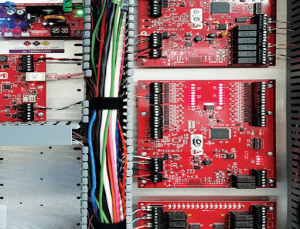
LAN cable vs Ethernet cable: Learn what LAN cable and Ethernet cable are and their differences
This article offers valuable insights into the essential components of networking, focusing on the differences between LAN cable vs Ethernet cable. It provides a thorough exploration of everything you need to know about the premise and LAN cables, including their types, uses, and the industries they serve. Whether you’re a tech enthusiast, IT professional, or simply curious about the networks that shape our daily lives, this guide covers all aspects of LAN cable vs Ethernet cable.
Learn about why these cables are so important to the modern world and the pivotal roles they play in diverse industries. Follow along as our cable experts break down the complexities and shed light on why LANs and premises cables have become indispensable in our modern era of connectivity. Welcome to a deep dive into the cables that connect us all.
What Does Local Area Networks Mean? (LANs)
Local Area Network, typically abbreviated as LAN, is a fundamental concept in the realm of computer networking. A LAN is a network of interconnected computers and devices within a limited geographic area, such as a home, office, or campus. The primary purpose of a LAN is to facilitate the exchange of data and resources among connected devices, fostering efficient communication within a clearly defined local space.
Where Did the Term LAN Come From?
The term “Local Area Network” can be traced back to the early days of computer networking in the 1960s and 1970s. As computing technology advanced, there was a growing need for systems that allowed computers to communicate with each other within a confined physical space. It was during this time that the concept of a “local” network limited to a specific geographic area gained prominence.
The birth of LANs is often associated with the development of Ethernet, a widely used technology for connecting devices in a LAN. Ethernet, conceived by Robert Metcalfe and his colleagues at Xerox PARC in the 1970s, played a pivotal role in the evolution of local networks. Its popularity grew as it became an industry standard, providing a reliable and scalable solution for connecting computers within close proximity.
What is The Difference Between LAN Cable vs Ethernet Cable?
In many networking conversations, people may mention “LAN” or “Ethernet cable” as if they mean the same thing, which can be misleading. When clarifying the difference between LAN vs Ethernet cable, it’s important to note that a LAN refers to a local area network—a group of interconnected devices within a specific space—while an Ethernet cable is simply the physical wire used to connect devices within that network. Although both are essential for wired networking, they serve different roles and should not be confused with one another.
What is a LAN Cable?
What is a LAN cable? A Local Area Network (LAN) is a digital network of interconnected computers and devices within a limited geographical area. LANs enable seamless communication, resource sharing, and collaboration among devices in proximity to each other. What is a LAN cable used for? These cables can be established using various technologies, with Ethernet being one of the most common.
What is Ethernet?
Ethernet, on the other hand, is a specific technology and a set of protocols that govern the way data is transmitted over LANs. This technology has become the de facto standard for wired LAN connections. It involves the use of Ethernet cables (such as Cat5e, Cat6, etc.) to physically connect devices, forming the foundation for data transfer within a LAN.
Key Differences: LAN Cable vs Ethernet Cable
When it comes to LAN, some key differences are that:
- It describes the network itself
- Emphasizes the local nature of the interconnected devices
- Encompasses a broader category of network technologies, including both wired and wireless solutions.
When it comes to Ethernet, the key differences are:
- It refers specifically to the wired technology and protocols governing data transmission within a LAN.
- Specifies the wired technology that uses Ethernet cables and follows standardized protocols
- Is the physical wired connection
Is LAN Cable the same as Ethernet Cable?
This is a common question since the two are so similar. Ultimately, Ethernet is a technology that can be employed to create a LAN, but not all LANs exclusively use Ethernet. For example, wireless technologies like Wi-Fi also fall under the umbrella of LANs. So, while Ethernet is a common and widely adopted technology within LANs, the terms are not actually synonymous.
Understanding this key distinction is crucial when discussing network setups and technologies. However, there is much more to LAN cable and Ethernet cable than this. There are also LAN cables, which you may hear referred to as Ethernet cables.
What are LAN Cables?
Local Area Network (LAN) cables, often referred to as Ethernet cables, are the key component of modern connectivity. These network cables serve as the physical infrastructure that facilitates the transmission of data between devices within a specific geographic area, such as a home, office, or plant. Understanding the intricacies of LAN cables is essential for grasping the foundation of network connectivity.
A LAN cable is a specific type of networking cable that is used to connect different devices. LAN cables assist in the connection between computers and other hardware to form a LAN. These are best used for small distances. If that’s unclear, don’t worry. An example of a LAN cable would be a home printer that connects to a router via a cable—a LAN cable!
What Do LAN Cables Do?
LAN cables serve a multitude of functions, enabling the seamless exchange of data, resources, and information among connected devices within the network. These network cables are the lifelines that empower businesses, manufacturing facilities, and households to share files, access the Internet, and run network-dependent applications. Essentially, LAN cables provide the connection needed to establish the LAN!
Are LAN Cables The Same as Ethernet Cables?
What Are Premise Cables?
Premise Cables are the wiring that is used to connect LAN and phone equipment within a building. It is made up of vertical and horizontal cable that runs from a central location such as a server room throughout the building to the individual desktops.
So Premise cables are what are used to create a local network. Data terminals, computers, video equipment and phone systems can be interconnected and networked together using copper cable. These cables run from a central location such as a server room throughout the building to the individual desktops.
What Type of Cable is Used for PREMISE wiring?
The standard Premise cable used for LAN drops is Category Cable. Specifically Cat 5e or Cat 6 since these Category 5e/6 Cables are a cost effective way to transmit data fast.
Remee Wire and Cable offers the two main types of LAN Premise cables category 5e and 6. In basic terms, the higher the number the faster the speed and the more regulated testing that is required to ensure that the wire eliminates cross talk. Both category 5e and 6 come in shielded and unshielded cable.
Shielded cable helps to protect from interference and is a better bet when the wire will be going from outside to inside (or reverse) or if it will be extending between walls from room to room. An unshielded category cable will work well to go from the wall directly into our computer.
Choose the Premise and LAN Cable Experts at Remee Wire and Cable
If you are looking for the best LAN cables for your local network then choose to partner with the experts in cable solutions. American made and operated Remee Wire and Cable. Aside from being one the best US cable manufacturers, Remee is family owned and provides larger cable manufacturer benefits with a small business level of commitment and customer service.
Need help with ordering LAN cables for your specific project? Give us a call at 800-431-3864. We would be happy to provide a sample of the LAN cable or any pricing and or delivery information.

